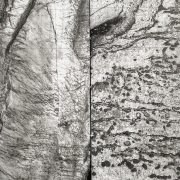Enver Hirsch & Philipp Meuser – Behelfsheim
The idea that built structures are vehicles for expressing ideology is widely accepted in architectural circles – think of the cool rationality of Le Corbusier’s apartment blocks, or the hubris of Albert Speer’s New Reich Chancellery. The political dimensions of architecture, on the other hand, emerge more spontaneously, in the gap between architect’s plan and built reality. If architectural aspirations are the stuff of cultural myth, in other words, such agendas are borne out (or resisted) in the act of building. The distinction is a blunt one, but it’s helpful in setting out a context for Enver Hirsch and Philipp Meuser’s Behelfsheim.
In the final years of the Reich, as Allied bombing campaigns reduced German cities to rubble, citizens were urged to construct their own homes out of whatever building materials they could salvage. Designs were supplied by the Reich, complete with illustrated step-by-step guides for everything from laying a foundation slab to pointing mortar with a dessert spoon. Over 40,000 Behelfsheim – ‘makeshift homes’ – were constructed in Hamburg alone. And although the Reich’s Housing Assistance Association didn’t intend them to be lived in after the end of the war, the permits that were issued to build the Behelfsheim allowed owner-occupiers to carry on using them indefinitely.

Hirsch and Meuser’s exterior photographs of the Behelfsheim bring to mind Joachim Brohm’s Typology 1979 – a study of the buildings erected on allotment communities in Germany’s Ruhr Valley. Brohm began his project with the intention of creating an architectural typology, but the buildings themselves – no two of which were alike – stubbornly resisted his attempts at classification. Any evidence of systematic construction has long since vanished from most of the Behelfsheim as well. The decades since they were built have seen them extended and adapted by their owners: some have been transformed into smart suburban homes or weekend cottages, others have been repurposed as garages or sheds, a few stand empty, earmarked for demolition. Photographed under the flat light of overcast winter skies, they are mostly unremarkable structures.
It’s in the interiors of the homes that the gap between plan and reality reveals itself most clearly, in photographs of patched walls, uneven floors and awkwardly fitted doorframes. Interleaved with pages of the original plans for the Behelfsheim – perfectly configured dwellings set out in neat rows – these interiors are testaments to the ingenuity, if not the skill, of their anonymous amateur builders. For the planners, individual lives were reducible to the generic functions of eating, sleeping and bathing; the inhabitants of the Behelfsheim, on the other hand, asserted their individuality in embellishments like flowered carpets, wooden panelling, and decorative tiles.
As markers of Nazi ideology, the Behelfsheim are obsolete. As homes, many of them are not, but their existence is under increasing threat.
The resourcefulness of their builders was regarded as a sign of allegiance to the Reich – aligned with the Nazi ideology of ‘total war’, which abolished the distinction between warfare and everyday life. In the decades following the war, however, the virtues that the Reich sought to cultivate in its citizens were replaced by a different set of values. Efforts to integrate the Behelfsheim with plans for postwar reconstruction were complicated by the unlimited usage permits, and the land on which many of the Behelfsheim stand is now valuable city center real estate.
As markers of Nazi ideology, the Behelfsheim are obsolete. As homes, many of them are not, but their existence is under increasing threat. In the middle of the book is a satirical one-act play, in the form of a fictional panel discussion, by the Hamburg authors Holger Fröhlich and Julia Lauter. At the end of a lively debate between developers, planners, and conservationists, the house itself speaks up: ‘Have a look around, this location, in the middle of greenery, in allotment gardens, in paradise. Surrounded by nature, instead of exhaust gas and noise. Usually you have to go to the country for that. Here the children play on the street without any danger, everyone takes care of each other …. We feel pretty special and really at home here, and we think we deserve monument protection.’
Domestic architecture is a peculiarly pliable kind of soft propaganda, easily transformed as the context around it shifts. Today, the Behelfsheim are emblems of a new and different struggle between plan and reality. Sitting placidly in their gardens – many of them surrounded by trees, but some, by evidence of encroaching development – they exude a permanence that’s belied by their precarious status. Behelfsheim makes a persuasive case for their preservation not as monuments to past conflicts, but as symbols of resistance to the more insidious malice of capital accumulation.



















